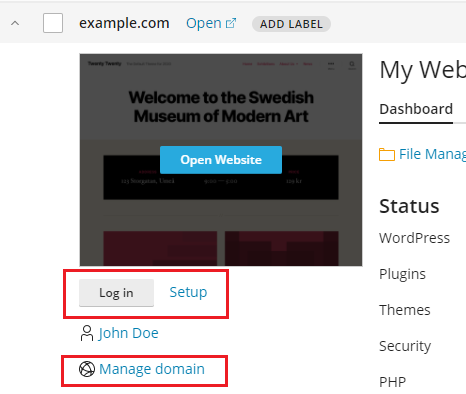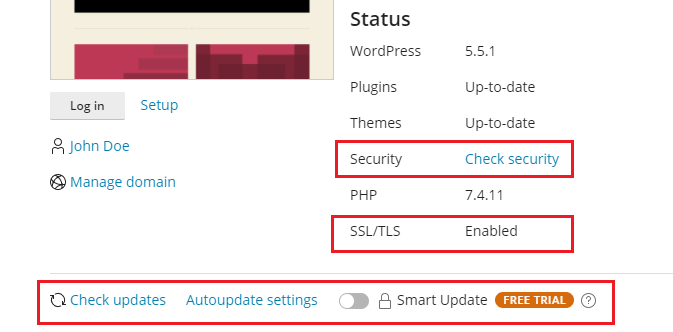Managing WordPress Installations
Go to WordPress to see all your WordPress installations.
WP Toolkit groups information about each installation in blocks we call cards.

A card shows a screenshot of your website and features a number of controls that give you easy access to frequently used tools. The screenshot changes in real time to reflect the changes you make to your website. For example, if you turn on maintenance mode or change the WordPress theme, the screenshot of the website will change immediately.
Note: Changes you make directly in WordPress are synchronized with WP Toolkit once every 24 hours. To sync manually, click the button.
When you move the mouse cursor over the screenshot of the website, you’ll see the following:
- Open Website button. To open the website in a new browser tab, click the button.
- Date and time the screenshot was updated last time. To update the screenshot right away, in the upper-right corner of the screenshot, click the icon.
Here you can also do the following:
-
Change your website name. To do so, click the icon, give your website a name, and then click .

-
Log in to WordPress as an administrator. To do so, click Log in below the website screenshot.
-
Change general WordPress settings. To do so, click “Setup” next to Log in.
-
Go to the domain’s screen in Websites & Domains. To do so, click Manage domain below the website screenshot.

Status
WordPress websites are frequently targeted by hackers. Outdated WordPress core, plugins, and themes also pose a security risk.
In the “Status” section, you can do the following:
- See if WordPress core as well as installed plugins and themes are up to date and update them if necessary.
- See if SSL/TLS support is enabled and, if not, enable it.
- See how safe is your website and enhance its security.

The controls in the “Tools” section give you easy access to the following settings and tools:
- “Search engine indexing” shows your website in search results of search engines.
- “Debugging” helps you debug a website that is not ready for viewing and being tested or developed.
- “Password Protection” specifies the password you will use to log in to WordPress from Plesk.
- “Take over wp-cron.php” helps you set up a regular run of
wp-cron.php.
Above the “Status” and “Tools” sections, you find the following WP Toolkit features:

- “File Manager” to manage the website’s files in File Manager.
- “Copy Data” to copy the content of your website to another.
- “Clone” to make a full copy of your website.
- “Back Up / Restore” to create a backup of your website and restore it if necessary.
- “Logs” to view WP Toolkit logs of the installation you need to troubleshoot.
At the bottom of the website card, you can do the following:
-
Enable Smart Update, a premium feature, which helps you keep your production websites up to date without the risk of breaking them.
-
Turn on “Maintenance mode”, which hides your website’s content from visitors.

On the remaining three tabs you can manage the installation’s plugins, themes, and change the database username and password.
Website Labels
Website labels are preconfigured identifiers that you can give to your websites (for example, “staging”, “production”, “testing”, and so on).
Depending on your project, it might be necessary to host multiple copies of a website for various purposes. Labels will help you distinguish one website from another.
By default, a website has no label. To label it, click ADD LABEL (on the website card next to the website name) and select the desired label. Labels are optional and you can change or remove a label at any time.
Managing Cards View
You can choose the way WP Toolkit shows cards. The default “Cards” view is best suited for a small number of installations. If you have a large number of installations, collapse cards .
You can also Filter installations to manage them easier.

Removing and Detaching Installations
You can detach WordPress installations that you do not want to see and manage in WP Toolkit. Detaching does not remove the installation, merely hides it from WP Toolkit. A detached installation will be attached to WP Toolkit again after you scan for WordPress installations. You can detach WordPress installations individually or multiple installations at a time.
To detach WordPress installations:
- Go to WordPress and then do the following:
- (To detach an individual installation) On the card of the installation you want to detach, click the icon.
- (To detach multiple installations) Select installations you want to detach and click Detach.
- Click Detach.
Unlike detaching, removal completely deletes a WordPress installation. You can remove any installation, no matter how it was installed: using WP Toolkit, through the Applications page, or manually. You can remove WordPress installations individually or multiple installations at a time.
To remove WordPress installations:
- Go to WordPress and then do the following:
- (To remove an individual installation) On the card of the installation you want to remove, click the icon.
- (To remove multiple installations) Select installations you want to remove and click Remove.
- Click Remove.
Search Engine Indexing and Debugging
By default, a newly created WP Toolkit website is shown in search results of search engines. If your website is not yet ready for public viewing, turn off “Search engine indexing”.
If you are installing WordPress for testing or development, you can enable “Debugging” to automatically find and fix errors in the website code. To do so, click the next to “Debugging”, select the WordPress debugging tools you want to activate, and then click OK.
